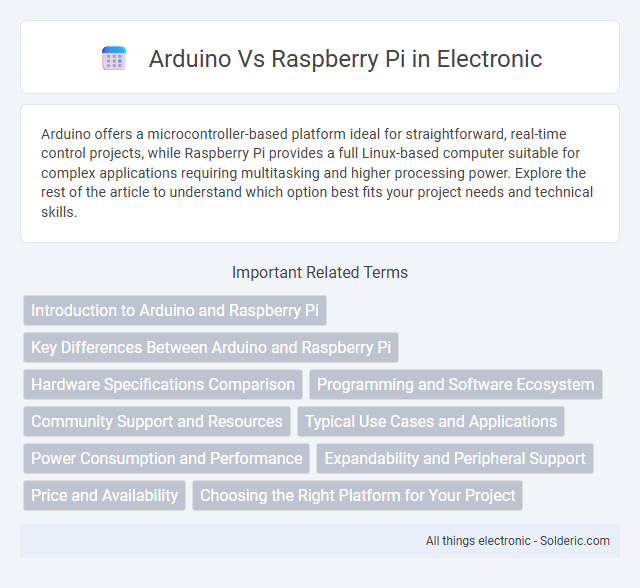Arduino offers a microcontroller-based platform ideal for straightforward, real-time control projects, while Raspberry Pi provides a full Linux-based computer suitable for complex applications requiring multitasking and higher processing power. Explore the rest of the article to understand which option best fits your project needs and technical skills.
Comparison Table
| Feature | Arduino | Raspberry Pi |
|---|---|---|
| Type | Microcontroller | Single-Board Computer |
| Processor | AVR, ARM Cortex-M (varies by model) | ARM Cortex-A (Quad-core or more) |
| Operating System | No OS (runs firmware) | Linux-based OS (Raspberry Pi OS, others) |
| Programming Language | C/C++ (Arduino IDE) | Python, C, C++, others |
| GPIO Pins | 14-54 digital I/O pins | 40-pin GPIO header with multiple functions |
| Connectivity | USB, UART, I2C, SPI (depends on model) | Ethernet, Wi-Fi, Bluetooth, USB, HDMI |
| Power Supply | 5V USB or external power | 5V via USB-C or GPIO pins |
| Use Cases | Embedded systems, real-time control, sensors | Multimedia, server, IoT, desktop computing |
| Price Range | $5 - $50 | $35 - $75 |
| Boot Time | Milliseconds | Seconds to minutes |
Introduction to Arduino and Raspberry Pi
Arduino is an open-source microcontroller platform designed for simple, real-time electronics projects, while Raspberry Pi is a compact, affordable single-board computer ideal for complex computing tasks. Both platforms support extensive community resources and versatile applications, but Arduino excels in hardware control, and Raspberry Pi offers full operating system capabilities. Your choice depends on whether you need direct hardware interaction or a powerful computing environment.
Key Differences Between Arduino and Raspberry Pi
Arduino operates as a microcontroller ideal for simple, real-time projects requiring low power consumption and direct hardware control, while Raspberry Pi functions as a full-fledged single-board computer capable of running a complete operating system and handling complex multitasking applications. Arduino uses a straightforward programming environment with C/C++ code uploaded via USB, whereas Raspberry Pi supports multiple programming languages and runs Linux-based systems for versatile software development. The difference in hardware architecture, processing power, and connectivity options distinguishes Arduino's focus on embedded control from Raspberry Pi's emphasis on computing capability and network access.
Hardware Specifications Comparison
Arduino boards typically feature microcontrollers with limited processing power, clock speeds ranging from 16 MHz to 480 MHz, and memory capacities around 2 KB to 8 KB of SRAM, making them ideal for simple sensor interfacing and real-time control tasks. Raspberry Pi devices offer significantly higher hardware specifications, including multi-core ARM processors running between 1.2 GHz and 2 GHz, 1 GB to 8 GB of RAM, and advanced I/O capabilities such as HDMI output, USB ports, and Ethernet connectivity for complex computing tasks and multimedia applications. Your choice depends on the hardware requirements of your project, with Arduino excelling in low-power, real-time control and Raspberry Pi suited for high-performance, multitasking environments.
Programming and Software Ecosystem
Arduino uses a simplified programming language based on C/C++, ideal for real-time control applications with direct hardware interaction. Raspberry Pi supports multiple operating systems like Linux and offers extensive programming flexibility, including Python, Java, and C++, suitable for complex multitasking projects. The Raspberry Pi's rich software ecosystem includes robust development tools, libraries, and community-driven resources, whereas Arduino's ecosystem centers around embedded programming with a streamlined IDE and numerous hardware libraries.
Community Support and Resources
Arduino boasts a vast global community with extensive forums, tutorials, and libraries tailored for hardware projects, making it ideal for beginners and hobbyists. Raspberry Pi, supported by a vibrant community of developers and educators, offers abundant resources including official documentation, software repositories, and online courses for advanced programming and multimedia applications. Both platforms provide rich ecosystems, but Arduino excels in hardware prototyping support, while Raspberry Pi leads in software and multimedia development resources.
Typical Use Cases and Applications
Arduino excels in real-time control applications such as robotics, home automation, and sensor interfacing, where low power consumption and precise timing are crucial. Raspberry Pi suits more complex computing tasks including media servers, web hosting, and educational programming projects due to its powerful processor and operating system support. Their complementary use often appears in IoT setups, combining Arduino's hardware interaction with Raspberry Pi's processing capabilities.
Power Consumption and Performance
Arduino excels in low power consumption, operating efficiently with minimal energy, making it ideal for simple, battery-powered projects. Raspberry Pi offers significantly higher performance with a multi-core processor and greater memory capacity, suitable for complex computing tasks but demands more power. Your choice depends on whether energy efficiency or processing power is the priority for your application.
Expandability and Peripheral Support
Arduino offers limited expandability with a focus on direct hardware control, making it ideal for simple sensor and actuator projects, while Raspberry Pi provides extensive peripheral support through USB, HDMI, and GPIO pins, enabling complex multimedia and networking applications. Raspberry Pi's compatibility with a wide range of external devices like cameras, displays, and storage solutions significantly outmatches Arduino's shield-based expansions. Your choice should align with whether your project requires robust multitasking capabilities and peripheral diversity or straightforward, real-time hardware interaction.
Price and Availability
Arduino boards are generally more affordable, with prices starting as low as $20, making them accessible for beginners and simple projects. Raspberry Pi devices, priced between $35 and $75 depending on the model, offer higher computing power but can face availability issues due to global chip shortages. Both platforms maintain wide availability through multiple distributors, though Arduino's simpler components often result in less supply chain disruption.
Choosing the Right Platform for Your Project
Arduino excels in projects requiring real-time control and low power consumption, making it ideal for tasks like sensor monitoring and simple automation. Raspberry Pi offers greater processing power and multimedia capabilities, suitable for complex tasks such as running full operating systems, web servers, or media centers. Selecting the right platform depends on project requirements including processing needs, power constraints, and programming complexity.
arduino vs raspberry pi Infographic

 solderic.com
solderic.com